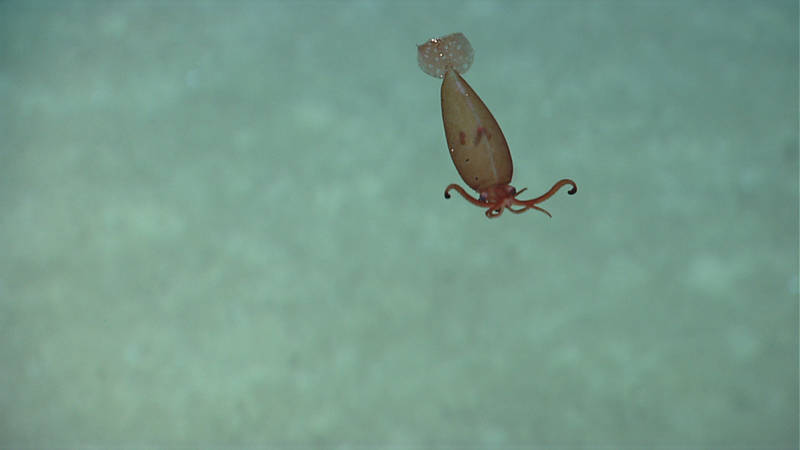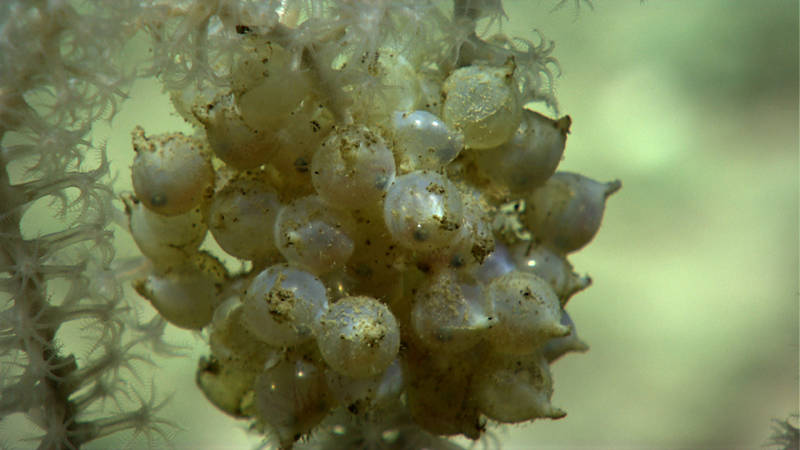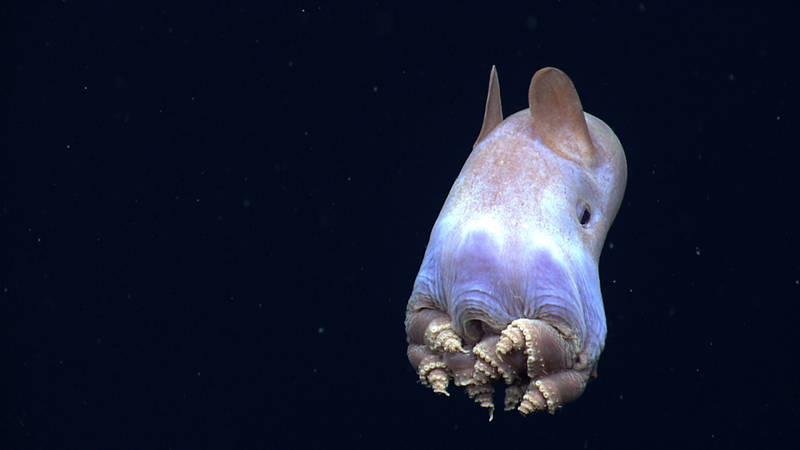
By Mike Vecchione - NOAA National Marine Fisheries Service National Systematics Lab, National Museum of Natural History
April 30, 2014

A spectacular find during dive 5, this deep-sea squid of the family Cranchiidae has a large chamber in its body filled with ammonia that it uses to help with buoyancy. Image courtesy of the NOAA Office of Ocean Exploration and Research, Exploration of the Gulf of Mexico 2014. Download larger version (jpg, 1.1 MB).
Teaching a deep-sea biology graduate course has made me interested in everything about the deep sea; however, my research focuses on the diversity of deep-sea nekton—the large, active, swimming animals. In particular, I specialize in cephalopods, the squids, octopods, and their relatives.
Unlike some of the other participating scientists who are interested in particular dive targets such as shipwrecks or chemosynthetic communities at hydrocarbon seeps, my animals may show up anywhere on any dive.
We didn’t encounter many cephalopods on this cruise, but those we saw were spectacular.
When the remotely operated vehicle was transiting between shipwrecks during Dive 5, it happened upon a deep-sea squid of the family Cranchiidae . This family is sometimes called “bathyscaphoid squids” because they have a large chamber in their bodies which they keep filled with ammonia that they produce by excretion. Because the ammonia is lighter than seawater, it provides buoyancy to counter the weight of muscles and other tissues. This is functionally similar to the flotation using light, incompressible liquids that was designed to counteract the weight of the heavy human-occupied sphere in a bathyscaph like the Trieste used in early exploration of the deep sea.

How good are your eyes—can you see tiny bobtail squid eyes inside these eggs? Image courtesy of the NOAA Office of Ocean Exploration and Research, Exploration of the Gulf of Mexico 2014. Download larger version (jpg, 1.3 MB).
The scientific name of this particular species is Leachia atlantica. The dark structures at the tips of the two long arms that it holds out to its sides are light-producing organs called photophores. It can use them to make startlingly bright flashes of light.
On two dives targeting deep-coral communities, we came across clusters of eggs attached to other biological structures, in one case a coral and the other a sponge. These are eggs from a family (the Sepiolidae ) of cute little “squids” called bobtails.
Although they are called squids, they are more similar in many ways, including their eggs, to cuttlefishes. On a couple of occasions during those dives, the HD video camera was zoomed in on coral rubble and bobtails were seen hiding in the rubble.

Identified as the highlight of the cruise by many of our scientists and viewers alike, this dumbo octopus displayed a body posture that has never before been observed in cirrate octopods. Image courtesy of the NOAA Office of Ocean Exploration and Research, Exploration of the Gulf of Mexico 2014. Download larger version (jpg, 990 KB). Watch video of the dumbo octopus.
Probably the most photogenic animal seen during the entire cruise was a cirrate, or “Dumbo”, octopod . As you can see in the image, the common name comes from the fins on the sides of the body, reminiscent of the large ears on the flying elephant in the Disney cartoon.
This cirrate belongs to the genus Grimpoteuthis but to be certain of the species identity we would have had to collect it. In this image, it has coiled its arms into tight spirals. I have seen many, many photos and videos of cirrate octopods and seen them do a variety of postures with their arms, but I have never seen one spiral its arms like this. This is a good example of the fact that every time we get a chance to explore the deep sea, we find something new and unexpected.